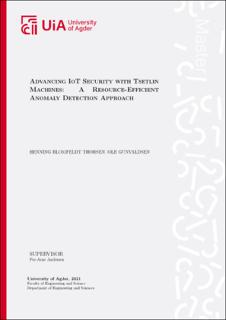| dc.description.abstract | The number of IoT devices are rapidly increasing, and the nature of the devices leave them vulnerable to attacks. As of today there are no general security solutions that meet the requirements of running with limited resources on devices with a large variety of use cases. Traditional AI models are able to classify and distinguish between benign and malignant network traffic. However, they require more resources than IoT devices can provide, and cannot train on-chip once deployed. This thesis introduces the Tsetlin Machine as a potential solution to this problem. As a binary, propositional logic model, the Tsetlin Machine is compatible with hardware and can perform predictions in near real-time on limited resources, making it a suitable candidate for intrusion detection in IoT devices.
To assess the viability of the Tsetlin Machine as an IDS, we developed custom data loaders for the benchmark datasets: CIC-IDS2017, KDD99, NSL-KDD, UNSW-NB15, and UNSW-Bot-IoT. We ran hyperparameter searches and numerous experiments to determine the performance of the Tsetlin machine on each dataset. We discovered that preprocessing data by converting each data value to a 32-bit binary number and imposing an upper bound on class sizes proved to be an effective strategy. Furthermore, we compared the performance of the Tsetlin Machine against various classifiers from the scikit-learn library and lazy predict. The results show that the Tsetlin Machine's performance was on par with, if not superior to, other machine learning models, indicating its potential as a reliable method for anomaly detection in IoT devices. However, future work is required to determine its viability in a real-life setting, running on limited resources and classifying real-time data. | |
